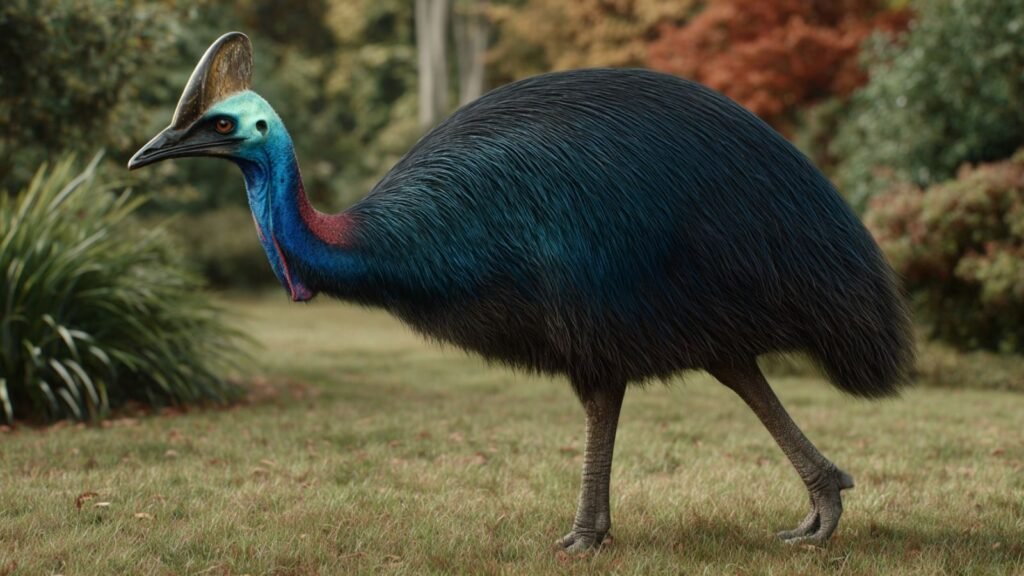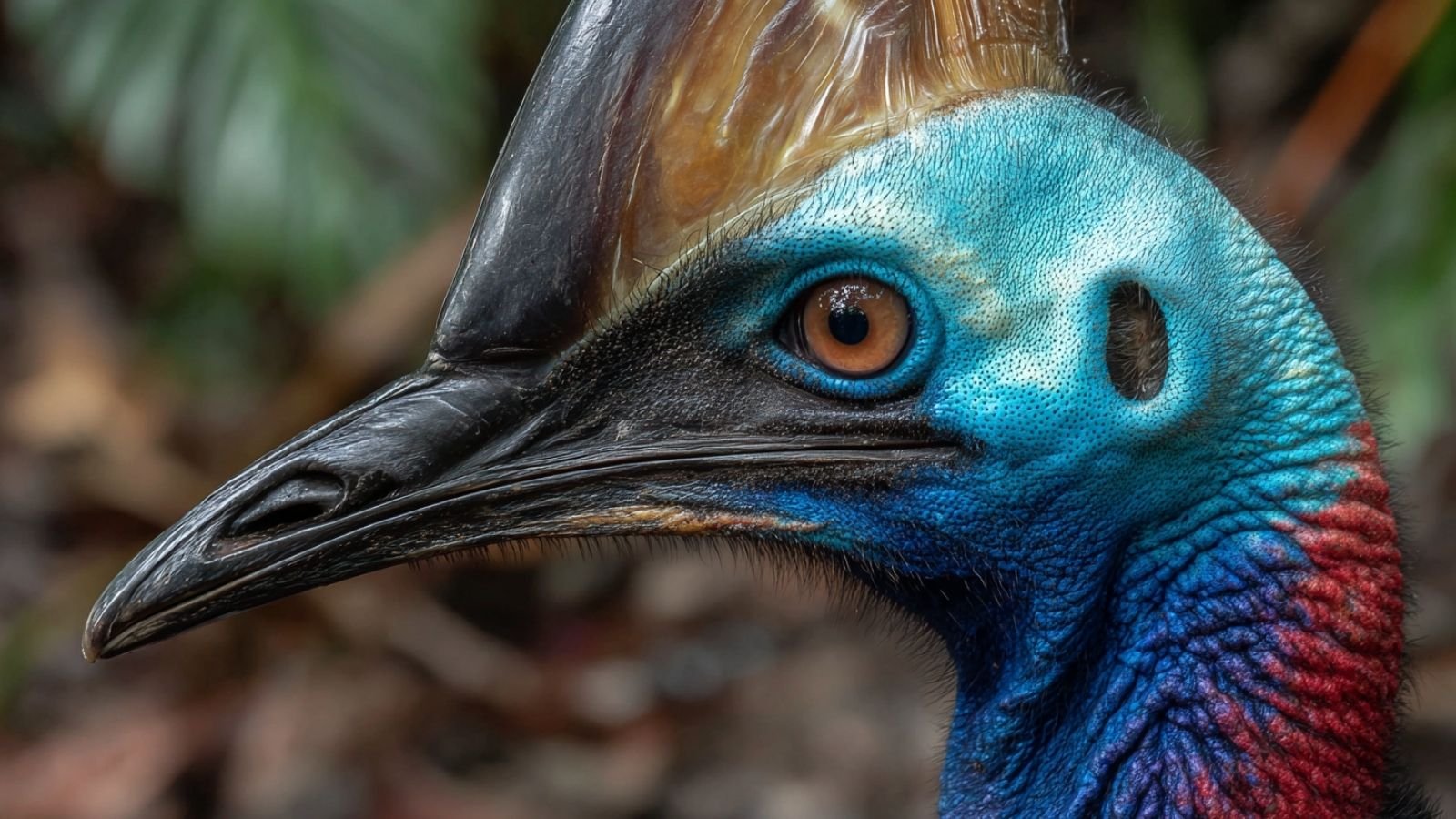Meet the Cassowary, the World’s Most Dangerous Bird
In the tropical rainforests of northern Australia and New Guinea lives a bird that looks like it stepped straight out of a prehistoric painting. It’s tall, glamorous in a punk‑rock sort of way, and has a reputation that makes even crocodiles slightly nervous. Meet the cassowary – or, as locals like to warn tourists, the world’s most dangerous bird.
At first glance, it doesn’t look like something you should fear. It has these glossy black feathers that resemble a haute couture coat, a neon‑blue neck that would make a parrot jealous, and a mysterious brown helmet called a casque. The cassowary’s gaze, however, says it all. There’s something quietly calculating in those amber eyes – as if it’s deciding whether you’re worth the energy it would take to kick you into next week.
Most of us are used to birds being nervous little things that fly away the moment you breathe too loudly. Cassowaries are the opposite. They don’t fly, but they don’t run from you either. They run at you. When cornered or annoyed, this bird doesn’t flap about. It lowers its head, lets out a deep booming call that vibrates in your chest, and charges with claws that would make a velociraptor proud. Those claws are sharp enough to slice through undergrowth – or, if you’re unlucky, through a human leg.
Yes, the stories are true. Cassowaries have injured dozens and even killed a few people over the past century. Usually, it’s the humans who start it – trying to feed them, take selfies, or get too close for a TikTok moment. But once provoked, the bird’s instincts take over. A single kick from its muscular legs can open up a wound that looks like it was made with a machete. Nature clearly didn’t want this bird to mess around.
Despite the horror‑film reputation, the cassowary is surprisingly shy when left alone. It spends most of its day wandering through the rainforest, minding its own business, snacking on fallen fruit. Think of it as the misunderstood celebrity of the avian world: beautiful, temperamental, and constantly pestered by paparazzi with GoPros. Its role in the ecosystem is crucial – cassowaries are basically the gardeners of the forest. They swallow fruit whole, seeds and all, and spread them miles away in their droppings. Many rainforest plants rely entirely on them for reproduction. Without cassowaries, the lush green jungle would slowly fall silent.
But of course, humans have a knack for turning ecological marvels into tabloid scandals. The phrase “world’s most dangerous bird” stuck partly because it’s catchy, and partly because, well, it’s true if you’re foolish enough to cross one. The Australian authorities have warning signs in cassowary habitats that look like something from Jurassic Park. They read: “Danger: Cassowary Attacks Can Cause Serious Injury or Death.” There’s even an official safety guide advising you to back away slowly and never turn your back on the bird. (Sage advice in general life, actually.)
The cassowary’s design is a marvel of evolutionary eccentricity. That casque on its head isn’t just decorative. Scientists believe it helps the bird push through thick vegetation like a battering ram, or perhaps acts as a resonator for those deep rumbling calls. Others think it’s a status symbol – a sign of dominance, a feathery crown. Either way, it adds to the creature’s prehistoric charisma. You can almost imagine a group of cassowaries strutting around 65 million years ago, judging the T‑Rex for being overdramatic.
The name itself comes from the Papuan word kasuweri, which roughly translates to “head with a horn” – very apt. Local myths tell stories of cassowaries as guardians of the forest or reincarnations of ancient spirits. In some Aboriginal traditions, the cassowary represents both creation and destruction – a reminder that nature gives life, but will also smack you back into the dirt if you disrespect it. And truly, nothing captures that duality better than a fruit‑eating bird that can disembowel you.
Still, not all encounters are hostile. People who live near cassowaries often speak about them with a kind of grudging respect, like how one might talk about an unpredictable neighbour who happens to be royalty. They know the warning signs: the fluffing of feathers, the tilt of the casque, the low drumming sound that seems to vibrate from the earth itself. Once you learn the etiquette, coexistence becomes possible. Keep your distance, don’t wave food around, and for heaven’s sake don’t try to pet one.

The cassowary’s swagger extends beyond its attitude. This bird is fast – it can sprint up to 50 kilometres an hour through dense jungle, and leap more than a metre into the air. Imagine that coming at you with talons like daggers. Even crocodiles think twice. There’s a legendary tale of a cassowary kicking a dog so hard it broke a rib. Another story tells of a farmer in Queensland who discovered a cassowary had jumped his two‑metre fence just to steal fallen mangoes. Fruit theft, apparently, is worth the athletic effort.
Despite the chaos it can unleash, cassowaries are in trouble. Habitat destruction, dog attacks, and car collisions have made them vulnerable. Northern Australia now counts fewer than 5,000 individuals. Ironically, the same humans who fear them are also their biggest threat. Conservationists spend their days repairing fences, planting fruit trees, and campaigning to protect the last patches of rainforest these birds call home. The cassowary might be the world’s most dangerous bird, but it’s also one of the most endangered.
That contradiction is part of what makes the cassowary irresistible to storytellers. It’s the ultimate anti‑hero – the bird you’d never want to meet in a dark alley, yet can’t stop admiring from afar. There’s poetry in its paradox: a killer with feathers softer than silk, a menace that keeps the forest alive. It forces us to remember that danger and beauty often coexist in the same body.
Tourists who head to Queensland or New Guinea hoping to see one often leave disappointed. Cassowaries are elusive, and most sightings last only a few seconds before the bird melts back into the green. But that fleeting glimpse is unforgettable. There’s something humbling about watching a creature that survived 60 million years of evolution give you a withering look, as if saying: “You lot are new here. Try not to ruin the place.”
It’s also a reminder that the world’s most dangerous bird doesn’t wake up thinking about us. It’s not plotting revenge or guarding its title like a boxer. It just wants peace, fruit, and a quiet stroll through the rainforest without humans sticking cameras in its face. The danger comes when we forget that we’re the visitors in its world.
Every now and then, though, the cassowary does make the news. A hiker gets too close, a suburban gardener finds one in the backyard, or someone posts a viral video of a cassowary crossing a road like a prehistoric supermodel. The comments section inevitably fills with jokes about dinosaurs and Australia being the world’s deadliest zoo. But hidden beneath the humour is admiration – for a creature that refuses to be tamed, that carries the wildness of the ancient Earth in its stride.
If you ever find yourself wandering through the Daintree Rainforest, and you hear a low, echoing boom that feels like it’s coming from the ground itself, stop for a moment. That’s the cassowary announcing its presence. Step back, stay calm, and consider yourself lucky. You’ve just met the world’s most dangerous bird, still strutting through the rainforest like it owns the place – which, technically, it does.
And perhaps that’s the real lesson here: the cassowary isn’t dangerous because it’s evil or aggressive by nature. It’s dangerous because it refuses to compromise. It doesn’t bend to us, doesn’t perform for the cameras, doesn’t pretend to be cute. In a world where everything wild is slowly being domesticated, the cassowary stands as a feathered reminder that some things should stay untamed.
